Recent Storm Damage Posts
Understanding the Impact of Freezing Temperatures on Homes
1/5/2024 (Permalink)
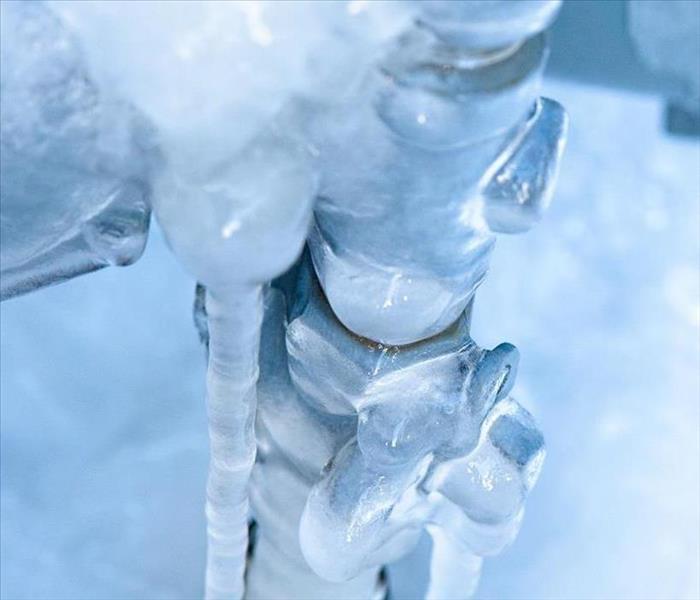 A frozen over pipe in winter.
A frozen over pipe in winter.
As winter's icy grip tightens, it brings with it a myriad of challenges for homeowners. Freezing temperatures can take a toll on our residences, causing potential damage that extends beyond the visible frost on windows. The most common concern is frozen pipes, which can burst and lead to costly repairs. Additionally, the contraction and expansion of building materials under extreme cold can result in structural issues and compromised insulation.
To safeguard your home, focus on insulation upgrades, weatherstripping, and regular maintenance of heating systems. Taking preventative measures, such as allowing faucets to drip during frigid nights, can help mitigate the risk of frozen pipes.
In the event that your home experiences a burst pipe or any other interior damage, call your local SERVPRO.
Snowmen, Snowangels, Snowstorms… We’re Snowverloaded!
1/1/2022 (Permalink)
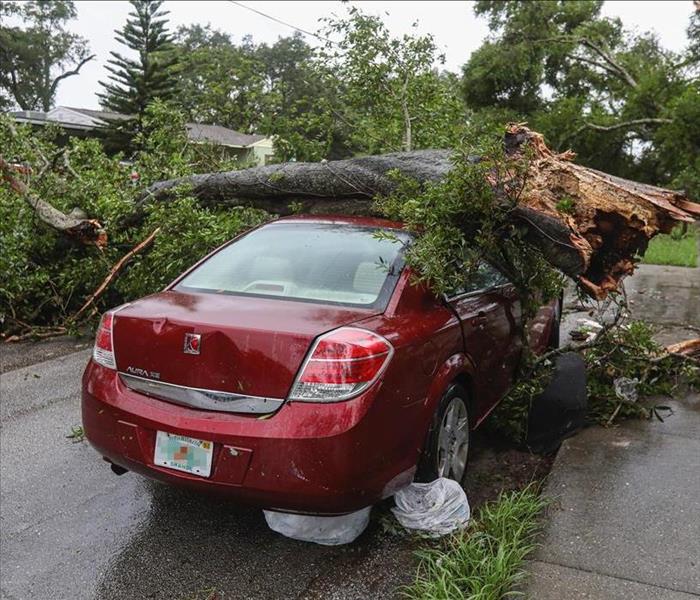 This guy was "too busy" to take care of that tree near his car, so nature picked up the slack for him.
This guy was "too busy" to take care of that tree near his car, so nature picked up the slack for him.
Winter is here, which means it’s getting chilly out there. When it gets chilly, water freezes. I’m not forging new ground here, but hang with me. This is gonna get useful!
Snowstorms and ice storms are an unusual mix of fun and danger. We’ve all made snowmen and snowangels outside after a good storm dumped some powder on us, but there are downsides too! Snow storms, and especially ice storms, can bring down trees near your house, destroying power lines, windows, roofs, (etc.)
It’d be prudent as the winter kicks up to be proactive and look around your property for any dead or dying trees or branches hanging out near your house or car or shed and trim those puppies up. It’ll take a few minutes of your time today in exchange for a huge headache later!
Three out of three property owners who trimmed the trees near their homes were grateful afterwards. (I only asked three people.) Now chop-chop!
What is my Risk for Lightning Damage?
12/6/2021 (Permalink)
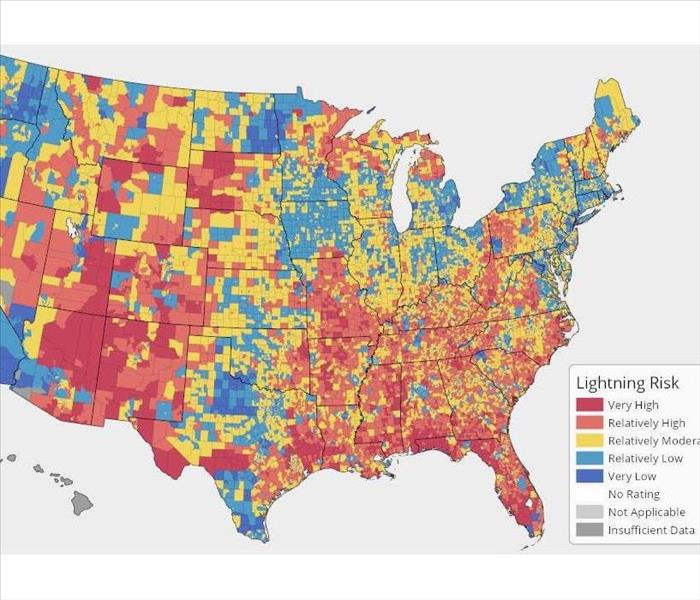 The red spots are red because they got burnt by all the lightning.
The red spots are red because they got burnt by all the lightning.
Thunderstorms are normally thought of as summer storms, but it’s not unheard of to have a thunderstorm during the autumn or winter! We call it “Thundersnow” where I come from, but I’m sure you have various regional colloquialisms to describe the phenomenon, and hopefully, they’re more creative than a simple portmanteau!
So what’s your risk for lightning damage? Luckily, FEMA puts together maps of our beautiful Nation for various natural disasters, so we can easily see what your risk is!
Check out the map linked above, or follow this link to learn more: https://hazards.fema.gov/nri/lightning
It looks like there aren’t too many regions where you’re entirely safe, which makes sense--thunderstorms aren’t exactly a rarity on this earth, especially in this continent!--however, some counties are safer than others. If you do happen to find yourself walloped by a thunderstorm this season, though, you can call SERVPRO of Greensboro North and we can come get things cleaned up and restored!
Two weeks until Hurricane Season Ends!
11/8/2021 (Permalink)
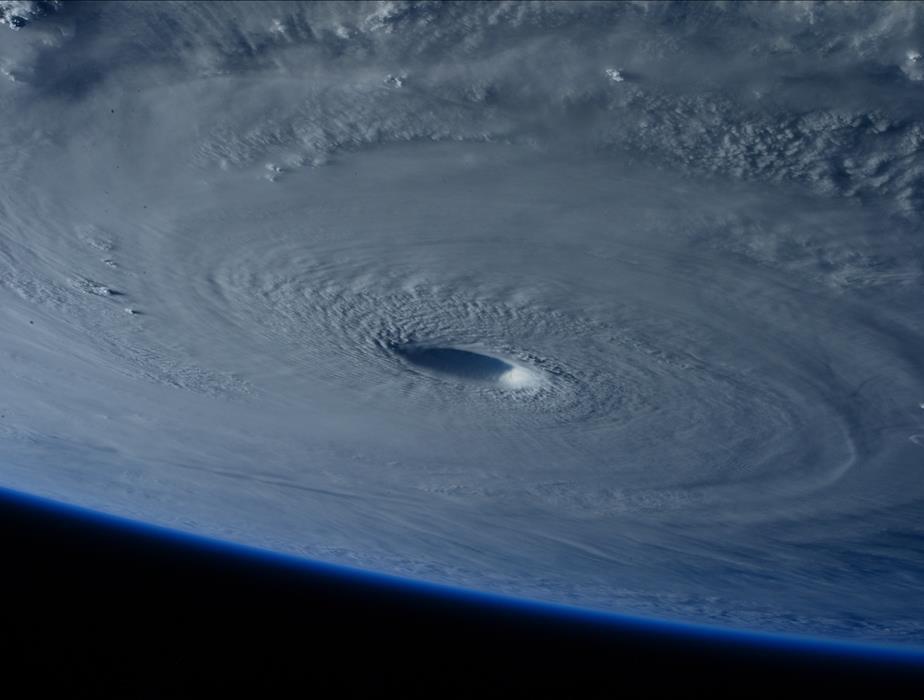 You can say goodbye to this tropical tempest for the next six months! (Unless you're in the Southern Hemisphere!)
You can say goodbye to this tropical tempest for the next six months! (Unless you're in the Southern Hemisphere!)
It’s been fairly quiet in the Atlantic Ocean lately, so you may be thinking the time for hurricanes in our area has passed. However, you would be wrong.
Hurricane Season runs from June to November, so we’re not quite out of the woods yet. The good news is there is a taper of sorts, so the last few weeks are far weaker than the middle few weeks, so we are hopefully smooth-sailing from here on out.
Hurricanes outside of the June-to-November season aren’t unheard of. They are, however, thankfully rare. Over the past 170 years (1851-2021), since hurricanes started being tracked in a centralised database, there have been only 87 hurricanes from December to May, which is about one every other year on average.
So is hurricane season over yet? Not quite. Is it basically over? Pretty much.
So take a deep sigh of relief and get ready for blizzard season.
What is your "Social Vulnerability" for Natural Disaster Damage?
11/2/2021 (Permalink)
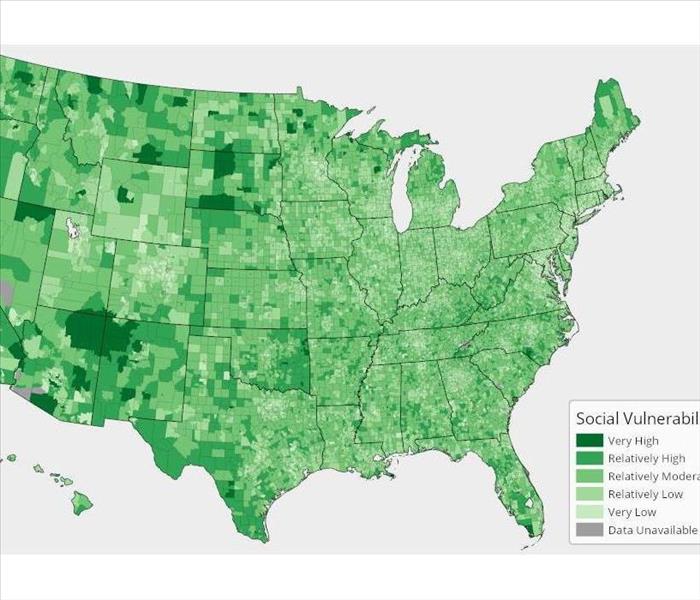 Turns out Kermit was right--it's hard to be Green!
Turns out Kermit was right--it's hard to be Green!
Natural disasters can strike anywhere, but certain regions are more likely to be exposed to different hazards, and some are more likely to experience catastrophic loss from said hazards. However, what you might not know is that there’s more to the equation than just climate, altitude, and weather. FEMA (Federal Emergency Management Agency) has a National Risk Index, which is an equation the department has created to break down risk by county or district. According to FEMA’s website,
“Social vulnerability is the susceptibility of social groups to the adverse impacts of natural hazards, including disproportionate death, injury, loss, or disruption of livelihood.
As a consequence enhancing risk component of the National Risk Index, a Social Vulnerability score and rating represent the relative level of a community’s social vulnerability compared to all other communities at the same level. A community’s Social Vulnerability score is proportional to a community’s risk. A higher Social Vulnerability score results in a higher Risk Index score.”
Check out the attached map to see your Social Vulnerability, and follow this link (https://hazards.fema.gov/nri/social-vulnerability) to get a closer look.
Stay safe, and feel free to call SERVPRO of Greensboro North at (336) 379-1772 if you find yourself in a Storm-based pickle, and we can come help pick up the pieces.
When does Hurricane Season End?
10/1/2021 (Permalink)
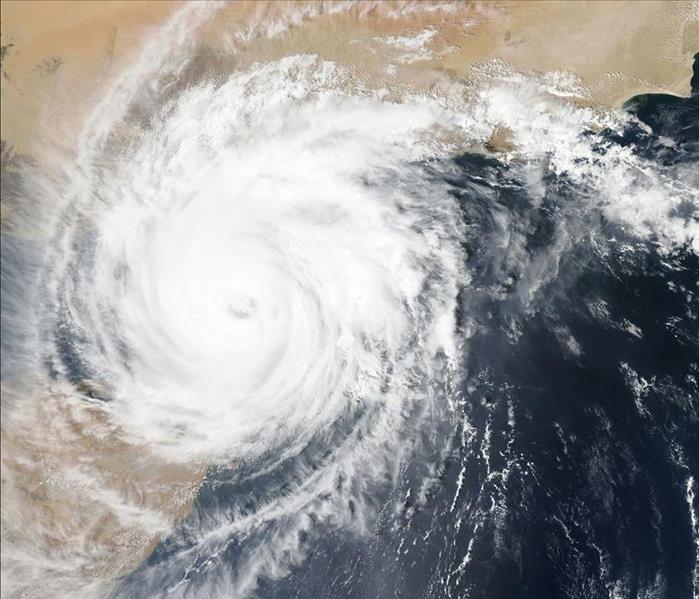 Only one more month, folks!
Only one more month, folks!
If you’re like most Americans living in a state on the East Coast, you might be wondering how much longer the Atlantic Hurricane Season will persist. Sure, we in the Piedmont Triad aren’t in too much danger from Hurricane Storm Damage, but Hurricanes and Tropical Storms can still bring high winds and rainfall to Guilford County. Power outages, fallen trees, and other storm damage can still happen as a result of a solid-sized storm, even if it just passes by the Outer Banks.
The Atlantic Hurricane Season lasts from June 1st until November 30th, however sometimes a storm will fall outside of that window. 97% of Hurricanes and tropical storms happen during the season, and outliers usually fall in May, not December, which is a good thing…for now. It won’t be as we get closer to May. We’ll cross that bridge when we get there, though!
Luckily, we only have two more months until Hurricane Season ends, but that doesn’t mean we’re entirely out of the storm. There’s still about ten weeks for things to spin out of control in more ways than one. If that happens to you, and the heavy winds and rain that can come as a result of tropical storms wallops your home or place of business, contact us at SERVPRO of Greensboro North, a premier cleaning and restoration company near you. Our Storm Damage Restoration Teams are franchise professionals, well-trained in removing debris and restoring your property so it’s "Like it never even happened."®
Steps to Help Prevent Trees from Falling on Your Home?
2/23/2021 (Permalink)
When people are looking to purchase a new house the curb appeal, amount of acres and layout are the primary focus. Counting the number of trees that surround the house is possibly the last thought on a prospective buyer’s mind. It’s essential, however, that house hunters do take into account how many trees there are near or on the property for the protection of their investment. Severe weather may pose the most likely risk to that investment through the possibility of ice storms in the winter and powerful winds in the spring.
An ice storm and powerful winds may cause weakened trees to fall on your property; through a window or even the roof. Pertaining to ice storms a quarter-inch of ice may begin to weigh down branches and a half-inch of ice may even lead to them breaking. Likewise, powerful winds from a hurricane, tropical storm or any other strong system that has the potential to spawn tornadoes may result in down trees. Especially if the ground is saturated from recent rainfall.
To help reduce the possibility of a tree falling on your home our team has listed several steps you can take below.
- Look to see if there are any trees on your property or even near it that may be weakened and pose a risk to your home. Perform this task regularly especially at the beginning of the winter and spring.
- Consider having a professional tree service company cut down trees that are weakened or are in close proximity to your property.
- Continuous severe storms can cripple a tree’s integrity leaving it vulnerable to a strong ice storm or hurricane completely toppling it over. After every storm makes sure to examine the trees around your home for abnormalities.
- Check with your home insurance provider to ensure you’re properly covered if a tree does fall on your roof.
If your home or business is in need of our services whether for fire, water, flood, mold, or storm damage; perhaps even deep cleaning services, call the experts today – SERVPRO of Greensboro North, (336) 379-1772.
Stopping Storm Damage In Its Tracks
12/4/2020 (Permalink)
2020 is a record-setting year for hurricanes. The National Weather Service even ran out of names and began using letters from the Greek alphabet. Along with numerous rainstorms this year, Alamance County including the Town of Elon has received above the average 45 inches usually expected. Going into the winter with the potential of blizzards and ice storms impacting Elon it’s critical that homeowners take precautions now to mitigate the potential losses in the future.
Protecting your home and the investment you’ve made in it from the updated kitchen to the remodeled basement requires that you take preventative measures. Working to reduce the likelihood of severe storm damage and water damage from flooding to your property. Serious damage to your home which may amount to thousands of dollars in equity gone down the drain due to a storm no matter the season it occurs in is a tragedy.
Poor foundation, inefficiently insulated entryways, and standing water around your home are some of the potential pitfalls of severe storm damage negatively impacting your home this winter. Heavy snow and ice melting near your home can possibly enter the structure including the basement damaging its integrity. To help prevent this from occurring be sure to review your property for any of these anomalies.
If water from a snowstorm or melted ice manages to seep into your home it’s critical that it’s mitigating quickly. Allowing standing water to take up space in your home’s basement or the first floor for any substantial amount of time may do more damage. SERVPRO of Greensboro North is an experienced storm damage and water clean-up crew with over two decades of experience in the water restoration industry. Two years ago our crew partnered with several SERVPRO franchises when hurricanes smash the coast. Our team is also IICRC Certified which is the industry standard.
If your home or business is in need of our services whether for fire, water, or mold damage; perhaps even deep cleaning services, call the experts today – SERVPRO of Greensboro North, 336-379-1772.
Potential Causes of Basement Flooding From Storms
10/29/2020 (Permalink)
Many homeowners dream of having a basement that they can truly make into their own space. Whether it’s for added living space, a man cave, or even a basement apartment. Adding features to a basement requires a substantial amount of investment. Therefore it’s paramount you protect your investment and the additional equity it has contributed to your property.
Hurricanes and rainstorms can cause significant damage to your home ruining the investment you’ve made. Flash flooding and torrential rainfall may make water cleanup a further ordeal you rather not encounter. There are several steps that you can take to minimize the likelihood of a basement flood which may lead to mold.
- Building a rain garden may assist in preventing excess rain from coming into your basement.
- Evaluate your basement and your entire home for any plumbing leaks.
- Review your basement windows to ensure they’re sealed correctly.
Your SERVPRO of Greensboro North team is experienced in the area of water cleanup, mitigation, and remediation. We’ve partnered with hundreds of homeowners during their water damage situations to resolve them effectively. Our area has experienced above-average rainfall for the last three years making these circumstances quite frequent.
If your home or business is in need of our services whether for fire, water, or mold damage; perhaps even deep cleaning services, call the experts today – SERVPRO of Greensboro North, (336) 379-1772.
What To Do Before Disaster Strikes?
9/14/2020 (Permalink)
September is both National Preparedness Month and also the height of the Atlantic hurricane season. Reminding everyone of the importance of having a plan in place when natural disasters occur. As the nation continues to combat the Coronavirus pandemic communities will need to revamp their strategy for keeping their residents while accommodating recommendations from your local health officials and the CDC.
Protecting yourself and your loved ones as a hurricane approaches can be exhausting. Stressing over the possibility of losing power to your home or if it’s flooded making it unlivable. All of those thoughts and the many more is why having a preparedness plan is critical. We’ve listed 4 core steps below, recommended by the Department of Homeland Security to assist you in developing a plan.
Make A Plan
Communicate with the members of your household on what you will do collectively in the event of a disaster before, during, and after to keep everyone safe. Inform loved ones outside of the household of your plans as well.
Build A Kit
Roads may be closed and stores flooded, limiting your access to resources. Thinking of everyone in your house and their particular needs especially infants, the elderly, and pets gather together goods that will sustain the group for several days.
Prepare For Disasters
Evaluate your home or business for potential weak points where strong winds or flooding can cause damage. Check with your insurance provider on what is covered to ensure there are few surprises if you need to file a claim.
Teach Youth About Disasters
Start a conversation with your kids about preparing for natural disasters and how they can do their part to keep everyone safe.
If your home or business is in need of our services whether for fire, water, or mold damage; perhaps even deep cleaning services, call the experts today – SERVPRO of Greensboro North, 336-379-1772.
https://www.ready.gov/september
https://www.epa.gov/natural-disasters/general-information-disasters
How To Brace Your Home For The Next Hurricane Part I?
8/14/2020 (Permalink)
June 1 began the official start to the hurricane season with two named storms Arthur and Bertha forming in the Atlantic. Hurricane Isaias developed in late July crawling up the east coast causing power outages and property damage in its wake. While the hurricane made a minimal impact on local residents, homeowners should prepare themselves for the next hurricane that may travel further inland.
Inches of rain can fall within hours as a hurricane track’s inland. Flooding a home’s basement and weakening the sewage system essential to any family’s well-being. To protect your home’s basement it’s critical you thoroughly inspect the pipes and sewage lines to see if years of wear and tear have impacted their reliability.
Floodwaters can also infiltrate your home’s basement through the windows. Ensuring that they’re properly sealed is a critical part of your hurricane preparation plans not only for the summer and fall season but year-round. Outside of the basement creating a landscape surrounding your home that diverts water away rather than towards may also help to limit the amount of floodwater.
If your property does experience damage due to flooding from a storm or hurricane, please call us. We’re staffed with an emergency team of water mitigation experts ready to assist you. The SERVPRO of Greensboro North team has also traveled to the North Carolina Coast previously to support disaster cleanup. You’re in good hands when choosing us to lead your home recovery.
SERVPRO of Greensboro North also serves the communities of
- Pleasant Garden, NC
- Mcleansville, NC
- Brown Summit, NC
- Oak Ridge, NC
- Summerfield, NC
If your home or business is in need of our services whether for fire, water, or mold damage; perhaps even deep cleaning services, call the experts today – SERVPRO of Greensboro North, 336-379-1772.
Your Storm Cleanup and Disaster Recovery Experts
6/5/2020 (Permalink)
Summer is a time to make boatloads of memories from evenings grilling out on your deck to weekends at your beach house overlooking the Atlantic Ocean. The incredible investment you’ve made in your property has created an emotional tie to it and protecting it as well as the memories created are important. Nevertheless, being aware of the potential harm that can come to your property are thoughts best kept in mind also. A possible threat to your property is a hurricane which can cause crippling damage.
Hurricane season began this month and it’s critical homeowners prepare for the storms that may impact their area. Whether it’s a property you own here in the Piedmont Triad or a second home out on the Carolina Coast it’s paramount you do all you can you safeguard the integrity of the structure. Hurricanes, tropical storms, and tropical depressions may bring strong winds, inches upon inches of rain, and possibly tornadoes which can all spell disaster for your property.
Two years ago both Hurricane Florence and Michael struck the North Carolina coast. The SERVPRO of Greensboro North team went into action as a storm clean and disaster recovery crew. We’re experienced in this arena not only from these two hurricanes but storms and tornadoes that have impacted Greensboro previously. We’re equipped and available to respond to your disaster situation when it happens.
If your home or business is in need of our services whether for fire, water, or mold damage; perhaps even deep cleaning services, call the experts today – SERVPRO of Greensboro North, 336-379-1772.
We’re In Spring In Case You Haven’t Noticed
4/8/2020 (Permalink)
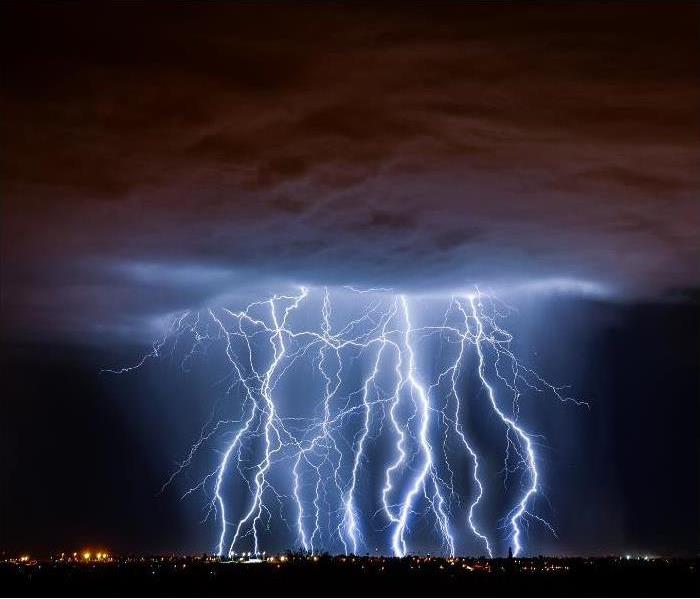 Thunderstorm with lightning over the city.
Thunderstorm with lightning over the city.
COVID-19 has captivated all of our minds and required us to change our movements as well as our lifestyles. With everything going on it’s quite easy to forget that we’re presently in spring where severe weather is most prevalent. While COVID-19 is the focus of our minds at the moment it’s crucial not to forget the dangerousness of severe weather. How it negatively impacts all of us and takes life as swiftly as any virus can.
Your SERVPRO of Greensboro North team wants to make the community aware that we’re still working and are ready to respond when severe weather strikes whether it’s heavy rain, flash flooding, hail, or a tornado which all can do significant damage to your property within a few short hours.
After severe weather strikes and you assess your property for any damage whether caused through the hail to your roof; perhaps a basement flood which is possible when heavy rains storm in. Flash flooding speaks for itself in its name and responding quickly is critical to minimizing the effects to your basement. Rainwater can also infiltrate your home through your door or if an object causes your home’s walls to falter. Nevertheless know that the SERVPRO of Greensboro North team is here when you need us.
SERVPRO of Greensboro North is available 24/7 to respond to your water loss situations and can be reached at (336) 379-1772.
You Can't Control The Weather
1/24/2020 (Permalink)
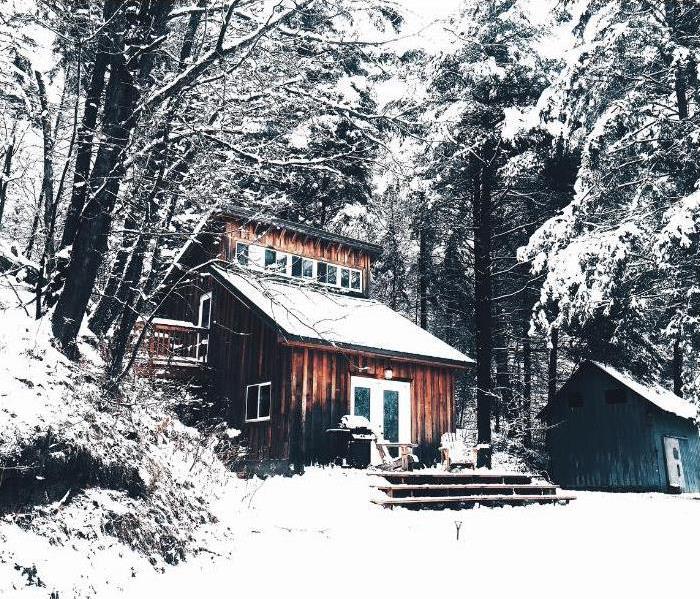 brown wooden house surrounded by trees
brown wooden house surrounded by trees
One of the facts of life is that we can’t control the weather. Rain, wind, tornadoes, ice, and snow are weather occurrences that are bound to happen especially in North Carolina where we tend to express all four seasons regardless of the current season we’re in. There are many steps that you can take to prepare your property for the impending elements, but if your property is damaged are you financially prepared to repair the damages.
Unfortunately, for many property owners who choose to forgo insurance are typically overwhelmed by the cost of restoration after the damage occurs. The importance of carrying insurance on your property even if it’s paid for can not be overstated. Older buildings are especially subjectable to damage from winter weather storms including snow and ice. Heavy snow on an older home can cause the roof to collapse causing serious damage to both the exterior and interior of your home. Cost may go well into the thousands which for most people are funds that aren’t readily available. Ice storms can cause trees surrounding your home to fall onto your home if the ice is thick enough.
Searching for the right insurance provider is paramount to protecting your property and your finances. Stay connected to SERVPRO of Greensboro North by following us on social media where will be posting blogs on how to screen insurance providers for the best one.
If you’ve experienced a fire and fire damage to your business or home, then call us at SERVPRO of Greensboro North. We can be reached at (336) 379-1772.
Winter Weather Preparedness for the Piedmont Triad
1/22/2020 (Permalink)
The Piedmont Triad area of North Carolina isn’t known for receiving snow and ice regularly throughout the winter season. Though when it does happen it is usually the top story in the morning, noon, and evening news for everyone to know about. There’s also typically an array of memes and gifs mocking how North Carolinians respond to snow before and during its arrival. Nevertheless the importance of being prepared for winter weather in our area whether it’s one huge snowstorm that blankets the entire triad or a few inches of snow that may receive the same response as if it were a blizzard. Keeping these tips in mind for protecting your property from the worst parts of the snowy and icy weather may save you a lot of stress and money in your bank account.
The first thing to do is keep yourself tuned in to your local news station for the most accurate forecast. In the age of the internet, many people have begun to forego the wisdom of their area meteorologists for weather updates from certain apps and sites. While there’s nothing wrong with staying up to date with consistent postings from online mediums the total reliance on them could spell disaster from the most detailed messages typically given by your local meteorologist. Take a few minutes out of your day to watch your local newscast on television or streaming service on their website. Doing so will help you prepare with the closest ton concrete information to protect your property from snow, ice, or sleet damage.
If you’ve experienced a fire and fire damage to your business or home, then call us at SERVPRO of Greensboro. We can be reached at (336) 379-1772.
Know What's Coming So You're Prepared For The Worst
12/16/2019 (Permalink)
 turned on flat-screen tv.
turned on flat-screen tv.
Every year it appears that Winter comes earlier and earlier with snowstorms and blizzards occurring even in parts of October. This past week a Winter snowstorm has crippled parts of the midwest and northeast with inches of snow. Being aware of the weather forecast is key to helping keep your property protected from the uncontrollable elements of the season.
As new weather forecast models and radar systems have been developed in the last several decades; meteorologists are able to more closely watch and predict upcoming weather systems. For the last half-century, or so the vast majority of people got their updates on the weather for the day and week from their local weatherman. Television was king along with a sliver of radio and in some fashion, local print news. With the advent of the internet though many more people now to receive the weather forecast for their local area through digital mediums relying less on television news. Being the cast it is still important for individuals to choose their media outlets wisely before taking what the site presents as conclusive.
Just a few tips to make sure you’re being given the best information weather-wise.
- Investigate to learn if the website or app you’re using for local weather updates is actually reviewed by actual people, or is it a computer just generating the report. That can be done by going to the about us or contact us page to learn if the team is located locally, or nationally. If it’s national then the chances are much higher it is generated by a computer and not deeply analyzed by a local news meteorologist for accuracy.
- Secondly, while new, innovative technologies have made weather forecasting a much more efficient process it is still not completely accurately especially with long-range forecasts that go out over a week. Typically forecast that goes out that far aren’t as reliable.
- Lastly, do a bit of research on weather forecasting of your own. Beforehand without the internet, the need to rely on local meteorologists to explain weather occurrences was much greater due to many people not knowing that much about the weather. Now everyone, for the most part, has access to this information.
If you’ve experienced a fire and fire damage to your business or home, then call us at SERVPRO of Greensboro North. We can be reached 24/7 and 365 at 336-379-1772.
Don't Let Winter Weather Do Harm To Your Property
12/16/2019 (Permalink)
This time last year the Piedmont Triad area was in the midst of thawing out from a record-breaking snowstorm that paralyzed commuting routes for residents and halted brick-and-mortar holiday shopping for days. Fortunately, the local news station meteorologist was able to equip the area with the important information necessary to ride out the winter storm. Interestingly enough the snow the area received for this area occurred before the official start of Winter and it turned out to be the only measurable amount of snow for the 2019-2020 winter season.
Nevertheless being prepared for when storms do roll through the area no matter if it’s a regular episode, or a once a season event. With knowledge of impending storms encroaching on the area, people were able to prepare efficiently for the possibility of their property being damaged by the winter weather. It’s important to take a look around your property to see if there are any weak points on your property where snow could damage a portion of it. It could be a gutter, downspout, or any exterior objects added to the property over the years. Also, evaluating the status of your roof, preferably by a professional is a key component of any winter weather preparedness strategy.
If you’ve experienced a fire and fire damage to your business or home, then call us at SERVPRO of Greensboro North. We can be reached 24/7 and 365 at 336-379-1772.
Preparing your home for Winter storms
12/3/2019 (Permalink)
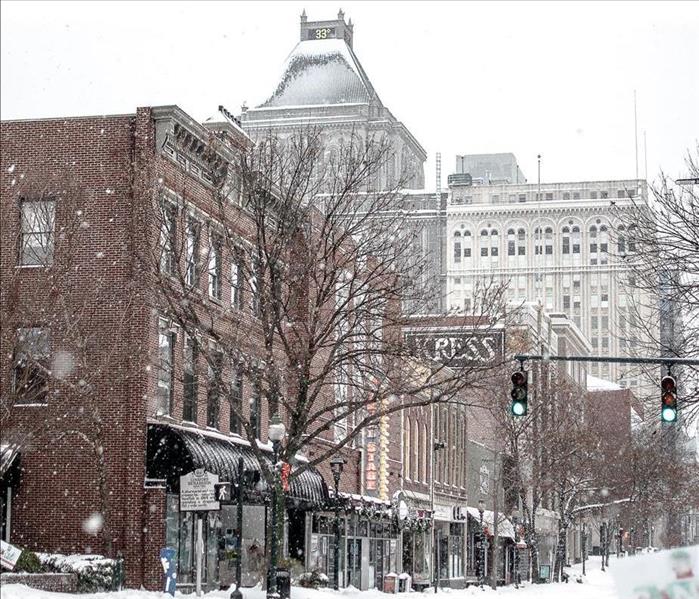 Downtown Greensboro covered in snow. Including the Lincoln Financial Group building, Kress Building, and Washington Street intersection.
Downtown Greensboro covered in snow. Including the Lincoln Financial Group building, Kress Building, and Washington Street intersection.
Though the official start of Winter isn’t until December 21 it’s imperative that property owners prepare now for severe weather including snowstorms, ice storms, and blizzards. Fortunately, your local SERVPRO Greensboro North team is here to offer you tips and advice on how to ensure your residence or office remains comfortable all season long.
First things first this Winter is to take a close look at the current status of your heating and air conditioning unit. It’s best to hire a certified HVAC technician to inspect your unit for any abnormalities. Routine maintenance is key to preventing a complete breakdown in your system.
Secondly, check around the outside of your property for any standing water. Check to see if there are proper channels for water to drain away from your property. The build-up of water around your property may contribute to the degradation of your home's foundation.
Lastly, evaluate the property itself for any damage, cracks, or holes where it may be possible for cold air to seep in. Sealing those holes throughout your property may help in lowering heating costs and keep you warm throughout the Winter season.
Storms Can be Damaging to Your Home
10/31/2019 (Permalink)
 Storms often bring with them heavy winds and heavy rain
Storms often bring with them heavy winds and heavy rain
Lots of storms come with high winds which can be damaging. Roof damage can be incurred from strong winds that may lift roof shingles, cause cracks, or remove part or all of the roof. Harsh winds and rains can shear away asphalt tiles. Flying debris can also cause cracks and holes in your roof. A small roof leak can produce damp, moldy conditions inside your home or business.
With heavy winds and rains also come floods. If your home or business is near water or in a low-lying area, flood water damage is a risk. Heavy rains and flooding may cause water damage even being many miles from the coast or miles away from any large body of water. If the land around your home or business cannot absorb the additional water flooding may happen.
If your home experiences storm damage then call us at SERVPRO of Greensboro North. We can be reached 24/7 and 365 at 336-379-1772
Steps to Take to Help Protect Your Home From Winter Storm Damage
12/14/2018 (Permalink)
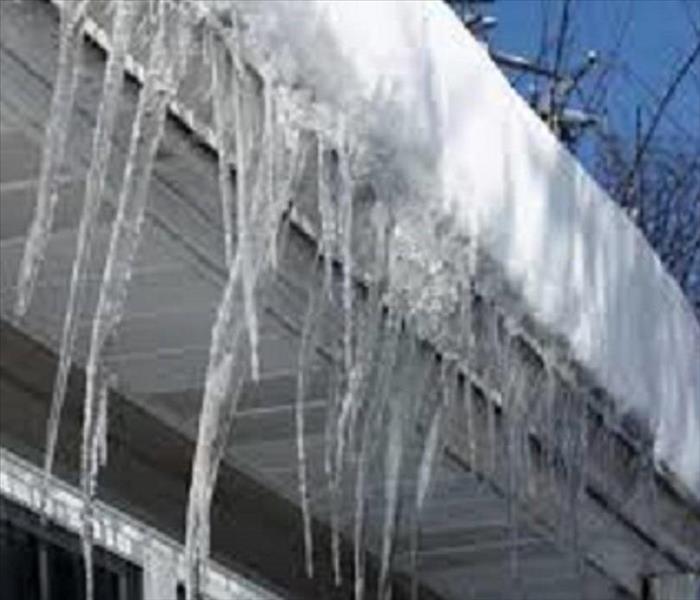 Icicles are a sign of Ice Dams which can cause major damage to your home.
Icicles are a sign of Ice Dams which can cause major damage to your home.
When winter sets in, storm damage is a big possibility. Winter storms are often accompanied by water damage. For instance, frozen pipes may burst during arctic temperatures, heavy snow piles on a roof can cause it to collapse, Ice dams can build on your gutters, trees can fall etc. Knowing what you can do to try and prevent damage from winter storms is important. Such as keeping tree branches trimmed and away from your house. Getting weaknesses in your roof or siding fixed. Keeping gutters clear, so that water and melted snow can drain away instead of freezing and forming ice dams. Below is a more in-depth info on some contributing factors of winter storm damage and tips on how you can try and prevent them.
- Your Roof
Heavy or constant wind can blow shingles loose or take off gutters. If damage like this occurs, it will let in moisture from sleet, snow, rain and meltwater into your home. Sometimes damage can occur to a part of your roof that you can't easily see, meaning you may not even realize that damage has been caused to it until after water starts coming in to your home.
Make sure your roof is winter-ready BEFORE a storm hits. Allow ample time for this prior to the season so that anything needing repair can be fixed before winter storms arrive. Inspecting your roof before a storm comes and making necessary repairs can often help to avoid storms from taking their toll on your roof. Clean all your gutters of any debris often, especially prior to a storm. Tarps if you have them offer a temporary fix in case any shingles loosen or blow off, but it is best to get a professional over as quickly as possible in order to address any damage before it worsens or leads to more issues. A professional can help you understand where you might need some preventative maintenance.
After a storm, you may need to arrange to have snow removed from your roof. As little as two feet of packed snow can be enough to cause a roof collapse. So, if it’s going to be too cold for snow to melt in between storms, or if one storm is expected to “dump” a lot more snow on top if what is already there, than that can lead to major roof damage. Reach out to professionals who have the knowledge, experience and proper safety equipment to work on the pitch of your roof and around ice.
- Your Gutters
Don’t forget about your gutters! Especially when tending to your roof. You want to ensure that your gutters stay clean and clear all year long but it is most important before any size winter storm hits to ensure that they are ready for it. If ice forms on your gutters the weight can cause them to fall right off of your home. Even without a major amount of snow, any accumulation of sleet or rain in cold temperatures can lead to a build up of ice in your gutters. Clean gutters allow water to easily drain out. As the weight of ice alone can cause damage, it is also for that reason to ensure your gutters are cleared so that additional weight on them is not a concern.
Ice is not the only concern, but ice dams. “Ice Dams” form when heat escapes from your home causing ice to melt along your roof and allowing it to drip to the edges and refreeze. Usually this causes icicles, which as pretty as they are, they are a sign that you’ve got a dangerous ice dam.
The best protection against the formation of ice dams is insulation. Prepare to prevent ice dams by sealing any gaps from light fixtures. That will help to keep warm air from rising into your attic. Also, it is best to insulate the attic itself to prevent heat from escaping out to your roof. Experts suggest keeping the attic temperatures no greater than 5 to 10 degrees warmer than the outside air.
Make certain too that your gutters are pointed away from your home. That way as any ice melts it lessons that chance of water pooling close by to your foundation, or flowing towards the side of your home which can allow water to seep into any cracks.
- Tree Branches
Low, or overhanging branches will most likely break during winter storms. While the appearance of snow on branches is pretty, the weight of the snow and ice weighs heavily on the branches below. Heavy, falling tree branches can damage your roof or other parts of your home. Any nearby power lines can also sustain damage if tree branches are not maintained and tumble below as a result of winter storms.
Trim all tree branches that surround your home in order to protect against damage. Be proactive by pruning all dead, broken and weakened branches as soon as they are spotted. Survey trees on your property often to look for broken or weak branches and also to try and determine the health and stability of the tree itself. Entire trees not only branches can come down due to winter storms by high winds or the weight of ice and snow. Trees that are not healthy are more susceptible to come down, becoming a major cause of damage.
In addition to the weight of ice and snow, melting snow as it puddles below ground can weaken tree roots causing trees to fall over. Unfortunately that can happen no matter how healthy a tree is.
- Snow Melting
Aside from just being able to cause trees to fall over, as snow melts, it poses a risk of water damage, such as flooding and mold to your home. As snow melts, a foot of snow can turn into an inch or more of water. Mold growth from moisture or flooding can happen quickly! Melting snow getting into your home can cause structural damage, like warping, floor separation and discoloration.
No matter what the cause of winter water damage to your home, at SERVPRO Greensboro North, our dedicated team of professionals are available to effectively evaluate and quickly repair the damage. We can be reached 24/7, 365 days a year at 336-379-1772. Be sure to give us a call in order to assist you.
Winter Storms Can Cause Lots of Damage
12/13/2018 (Permalink)
 Snow as it is pretty, can be very damaging to your home
Snow as it is pretty, can be very damaging to your home
It appears Winter 2018 has begun early here in the Triad as well as throughout most areas of the country. With weeks to go until the official start of winter on December 21st snow has already fallen and here in the Triad it’s snowed in record breaking, history making amounts. According to the Farmers Almanac North Carolina is just one area that the Almanac says will experience "above-normal" precipitation and the region will have a "wintry chill, wet & white" winter in 2018. So, it seems we’ll have plenty of more snow to come before the first signs of Spring. Plus of course if the Groundhog sees its shadow, we may also be in for a long winter.
It is always best to be prepared for winter storms in advance in order to protect your home, business and your family. In addition to snow accumulation, winter storms can bring along conditions that can affect your home on the inside and outside. When you know what type of damage can be caused by snow storms, it’s easier to find its effects and get them fixed as soon as possible. Even after snowfall, winter storms can bring and cause other challenges. Here are some possible types of Storm Damage from winter storms.
1. Strong winds may loosen roof shingles.
2. Strong winds might also pick up rocks or other small items and throw them against your siding or windows.
3. Snow or ice could sneak inside holes in your foundation, roof, siding etc.
4. If trees, especially large ones are growing close by to your home, tree branches could fall onto your roof during a storm or scrape against your homes siding. If those trees are older or if the melting snow saturates the ground enough, it can also cause trees to fall onto your home.
5. Ice dams may block water from going down gutters, and force water to go under shingles instead. They can also cause your gutters to collapse.
6. Heavy snows can cause your roof to collapse.
There are actions you can take ahead of time to help keep your home more secure during a storm. Check out our blog on How to Protect Your Home from Winter Storms for information on what you can do to prevent Storm Damage.
If a winter storm does leave a mark on your home, we recommend you take action immediately. It is wise to address storm damage issues while they are relatively small in order to prevent them from getting worse in the next storm. Small or big, at SERVPRO Greensboro North we are here for you should your home or office experience storm damage. We are available to assist 24/7 365 days a year. Just give us a call at 336-379-1772
Precautions and Safety Measures to Take Before and After A Storm Hits
11/28/2018 (Permalink)
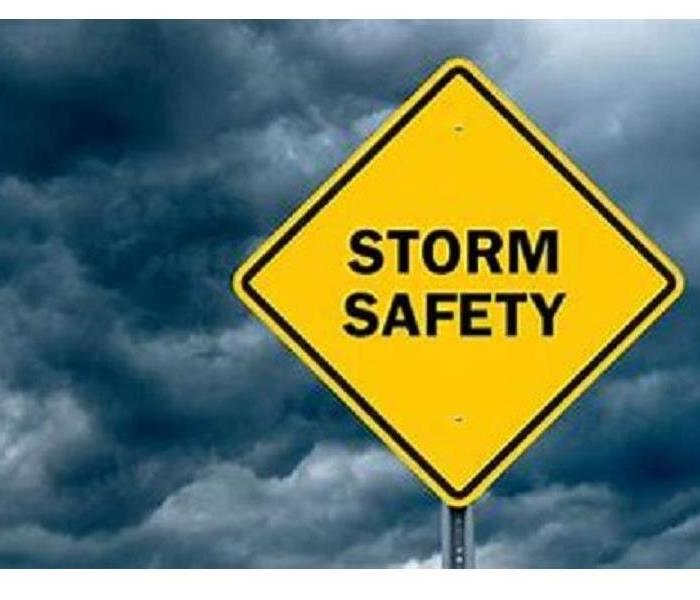 Storm safety should be taken seriously in order to protect you, your family and your home
Storm safety should be taken seriously in order to protect you, your family and your home
As mother is nature is often unpredictable, storm damage can occur at any time and can cause an immense amount of harm to your home. With so many types of storms, such as tornado, hurricane, blizzard, monsoon etc. it is often that damage to your home may be the result of one. Heavy rains often cause flooding and stronger than normal winds can cause damage to your roof be it from too much rain or downed trees. Having a strategy in place to deal any damage you may incur, will help you to be ready to take necessary steps immediately after the storm.
Safety Precautions
Heavy winds and rain can create many hazards. They can cause your roof to collapse, cause window damage, collapsed interior walls or cause flooding in your in your basement or in other areas of your home. Moisture can also be increased and soak into furniture, carpeting, and building materials making anyplace and anything the perfect environment for mold to grow. Shut off the main power box to your home if you have flooding. Shut off the main gas line if you smell gas. Watch out for broken glass, exposed nails, other sharp objects and collapsed materials on your property or in your home.
Call in professionals in restoration, like us at SERVPRO Greensboro North to assist. We can be reached 24/7 at 336-379-1772 We will make sure your property is safe to use and be able to restore it.
In case you must entirely vacate your home, make sure that you have a backup as to where you would stay in case damage to your home were to arise.
It is good to have current and updated photos of your belongings and your home prior to any natural disaster. That way in case you do experience damage or loss of items, you can show insurance both your before and after photos. At SERVPRO we help to photograph the storm damage. If it is not determined safe for you to be on site at your home, then it is not recommended that you take any photographs of the damage. We will provide photos to you and your insurance. That will help to ensure that you are fully compensated.
Federal Disaster Assistance May be Available
11/28/2018 (Permalink)
 Look into whether or not you qualify for Federal Disaster Relief
Look into whether or not you qualify for Federal Disaster Relief
Federal Disaster Assistance Should be Looked Into
After mother nature comes through with storms such as hurricanes, tornadoes, monsoons, etc., depending on the severity if the storm and the amount of widespread damage it has caused to an area, than Federal Assistance may be available to you. So long as the federal government has declared the area as affected by the storm and labeled your area as a disaster area than that should make you eligible for low-cost loans. These Federal loans can help aid in the cost to help restore your property back to its pre storm condition. You will be required to file documents to receive these loans. Make sure to request all necessary documentation from them if your area is eligible for loans.
When disaster strikes from sudden storms, it can feel overwhelming. SERVPRO Greensboro North is here for you 24/7 in order to assist and to restore your home. Call us at 336-379-1772
Storm Surges
11/22/2018 (Permalink)
 Storm Surges are when water rises and rushes ashore
Storm Surges are when water rises and rushes ashore
So what is storm surge, how and why does it happen and why should you be wary of it and heed warnings?
Well for starters, storm surge happens when water is pushed onshore by a hurricane.
A storm surge forms as the ocean water is pushed by winds and waves, and is also sucked into the air near the eye of the hurricane by low pressure. AJC.com suggests that you should imagine a bowl of water. Put your hand in the middle of the bowl and cup it. Now slowly push your hand toward the edge of the bowl. Those are the same dynamics as storm surge.
While it can be confused as such, a storm surge is not a wall of water that rushes in onto the shore. It is typically a rise of water which often happens quickly, moving at the same rate as the forward speed of a hurricane.
Surges are very powerful!! Only 1 cubic yard of sea water weighs 1,728 pounds. A 6-inch surge can knock a person down. It can and will take out and destroy things in its path due to either force and/ or a combination of force and pressure from flood water.
Storm surges kill more people in a hurricane than any other components of the storm. It is for this reason alone that it is always encouraged to evacuate from areas along the shore, or from smaller islands where there isn’t much inland area to seek what’ll remain as dry land. The overwhelming majority of deaths which are in part of the 10 deadliest U.S. landfalling hurricanes were the result of storm surge alone.
Get away from storm surges. Your life, your families lives, your pets lives depend on it. It isn’t worth the risk to take your chances and stay behind. Especially when evacuation orders are in place. While yes, meteorologists can predict wrong, it’s often only due to how unpredictable these storms can sometimes be. Safety and evacuation measures should be taken and obeyed though as it’s not recommended to gamble with your life. First responders lives are then also placed directly in jeopardy when having to go in to rescue those who choose to “ride out the storm” by not evacuating.
A surge 1 foot deep can take a car off a road. Getting out early is key because the surge can begin up to 24 hours before the storm makes landfall. According to AJC.com during Hurricane Katrina, people stayed in their homes and died there when the surge filled their homes with water and they could not escape. Also, don’t leave pets at home. Many animals died when people left them in their homes during Hurricane Katrina.
What does a 9-foot, 10 -foot etc storm surge mean?
According to AJC.com It depends on the sea level at the point where the water begins “The storm surge is how high above current sea level the ocean water gets. The number we are most interested in regarding storm surge is how many feet above mean sea level (MSL) inundation will occur. This number is known as the storm tide ... The storm tide is the height of the storm surge above the MSL, corrected for the tide.
“For example, in a location where high tide is 2 feet higher than mean sea level, and low tide is 2 feet lower than mean sea level, a 15-foot storm surge would cause a 17-foot storm tide if the hurricane hit at high tide or a 13-foot storm tide at low tide."
Storm surges are going to cause flooding to your home whether you are in it or not. Again it is best to evacuate and in a timely manner. Once it is deemed safe to return to your home, it is then that SERVPRO is here to assist. We are here to assist not only with flooding due to storm surge or lots of rainfall, but also with storm damage resulting from high winds. Give SERVPRO Greensboro North a call 24/7 and if we are not nearby, we will be able to connect you with a SERVPRO in your direct area.
Hurricane Florence Hit NC
11/22/2018 (Permalink)
 Hurricane Florence Satelite Photo
Hurricane Florence Satelite Photo
According to weather.com, Hurricane Florence made landfall in North Carolina as a Category 1 hurricane. The hurricane caused devastating flooding, major storm surge flooding and damaging winds. Florence made landfall near Wrightsville, North Carolina, at 7:15 a.m. EDT Sept. 14 with maximum sustained winds around 90 mph. Florence’s storm surges reached 10 feet above normal levels.
Storm surges are extremely dangerous, more so than hurricane strength winds. More people lose their lives because of flooding from the surge, then from the storm’s winds. Hurricane Florence’s storm surges along with her extreme amount of rain cause deep floodwaters throughout many areas, especially along the NC Coastline. Wilmington, NC is one area that experienced extreme flooding. However inland areas experienced lots of flooding as well due to the slow speed in which the storm moved and to the abundant amount of rainfall that it dropped in all areas over the course of several days.
Florence caused many creeks, rivers, lakes and canals to rise and overflow, including in the triad area of NC. Right here in Greensboro SERVPRO Greensboro North responded to several calls for flooding inside homes due to rising waters or roof damage caused by high winds and rain from the storm.
If your home ever experiences flooding, water damage or mold due to a storm than call us SERVPRO Greensboro North at 336-379-1772 We are able to be reached 24/7 in order to assist you.
When Storms or Floods Hit Greensboro, SERVPRO is Ready!
5/23/2016 (Permalink)
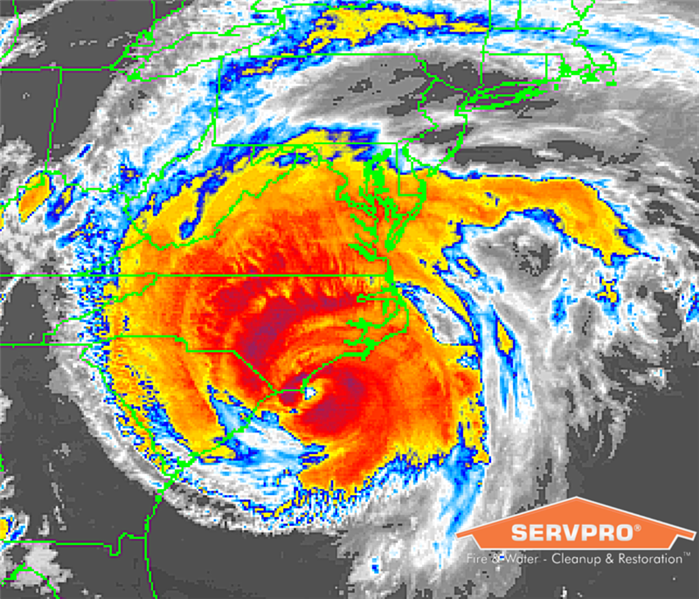 Our highly trained crews are ready to respond 24/7 in Greensboro and surrounding areas!
Our highly trained crews are ready to respond 24/7 in Greensboro and surrounding areas!
SERVPRO of Greensboro North specializes in storm and flood damage restoration. Our crews are highly trained and we use specialized equipment to restore your property to its pre-storm condition.
Faster Response
Since we are locally owned and operated, we are able to respond quicker with the right resources, which is extremely important. A fast response lessens the damage, limits further damage, and reduces the restoration cost.
Resources to Handle Floods and Storms
When storms hit Greensboro and surrounding areas, we can scale our resources to handle a large storm or flooding disaster. We can access equipment and personnel from a network of 1,650 Franchises across the country and elite Disaster Recovery Teams that are strategically located throughout the United States.
Have Storm or Flood Damage? Call Us Today at (336) 379-1772.
Preparing your home and business for Winter Weather
1/20/2016 (Permalink)
The weather man is calling for some winter weather this week in the triad so here our a few of our tips for how to keep your home and business disaster free.
• Keep cabinets in your kitchen and bathroom open to allow warmer air to circulate around the plumbing.
• Keep a slow trickle of water flowing through faucets, especially if the pipes for faucets run through unheated or uninsulated areas of your home.
• Consider installing specific products to insulate water pipes, such as “pipe sleeves” or just use a dark colored sock for outside spigots.
• Consider shutting off outdoor faucets. Find the shut-off valve in the basement or crawl space and turn it to “off”. Then make sure the outdoor faucet is open to help it drain completely while the inner valve is shut off.
• Ensure gutters are clean and secure. Allowing debris to accumulate could cause damming effects on gutters, leading to roof and water damage.
• If you are traveling, leave your furnace set to a temperature no lower than 55° F.
•Inspect property and pay specific attention to downed tree limbs and branches. Walkways and parking lots should be inspected for proper drainage. potential slippery or hazardous areas corrected with mats or non-slip surfaces.
•Preform or have a professional preform proper maintenance on your furnace.
•Contact SERVPRO about having an Emergency Ready Plan done for your business to ensure you are ready for any type of disaster.
•Contact SERVPRO of Greensboro North, Burlington and Kernersville at (336) 379-1772 for help when winter weather strikes.






 24/7 Emergency Service
24/7 Emergency Service


















